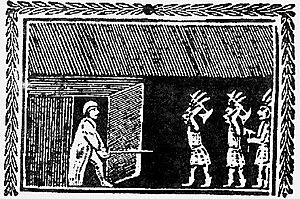First Abenaki War facts for kids
The First Abenaki War was a conflict that happened a long time ago. It took place mostly in what is now Maine. This war was also known as the northern part of King Philip's War.
It was fought between English settlers and Native American tribes. These tribes later formed the Wabanaki Confederacy. Important leaders included Richard Waldron and Charles Frost for the English. Jean-Vincent d'Abbadie de Saint-Castin worked with the Native American tribes.
The Native Americans launched attacks on English settlements every year. These attacks happened in 1675, 1676, and 1677. English forces even attacked the Mi'kmaq people further north in Acadia.
A historian named Georges Cerbelaud Salagnac said that Saint-Castin and the Abenaki were very skilled fighters. They managed to stop 700 English soldiers. They even caused some big defeats for the English. Records show that 260 English people were killed or captured. Many villages like Cape Neddick, Scarborough, and Casco were destroyed. The war was very expensive for the English government.
Contents
Why the War Started
Jean-Vincent d'Abbadie de Saint-Castin was sent from Quebec in New France. His job was to get all the Native American tribes in Acadia to support the King of France. Saint-Castin settled among the Abenaki people.
Around the same time, King Philip (Pometacom) and his warriors were fighting in New England in 1675. Some historians believe Saint-Castin started to help the Wabanaki with their war plans. He might have also given them better weapons. People in Boston thought Saint-Castin was a big influence on the Wabanaki strategy.
Key Events of the War
Attacks in 1675
In the Northeast Coast Campaign of 1675, the Wabanaki Confederacy attacked English settlements. These were along the border between New England and Acadia in Maine. They killed eighty English settlers. Many farms were also burned down. These attacks stopped the English from expanding their settlements. Many settlers left their homes. Only areas south of the Saco River still had English people.
Attacks in 1676
The Northeast Coast Campaign of 1676 continued the attacks. In the first month, they destroyed a large part of the coast east of Casco. They killed and captured more settlers. Many farms were burned again. This forced the English to leave the region. They retreated all the way to Salem.
This campaign was important for a few reasons. Richard Waldron joined the war. A Native American leader named Chief Mogg was killed. Also, an attack on the Mi'kmaq people brought them into the war.
In August 1676, Native Americans attacked a settlement near the Sheepscot River in Maine. A man named Sir William Phips was there. He saved many local settlers by letting them on his ship. He had to leave his valuable lumber cargo behind. Even though he lost money, people in Boston saw him as a hero.
Attacks in 1677
The Northeast Coast Campaign of 1677 saw more attacks. The Wabanaki Confederacy raided English settlements in Maine again. They continued to kill and capture colonists. They also burned many more farms. These actions kept stopping the English from expanding.
After the War

After King Philip's War and King William's War (1689–97), many English settlers moved. They went from northeastern Maine and Massachusetts to bigger towns. This was to avoid attacks from the Wabanaki people.
The fighting in the northern area ended with the Treaty of Casco (1678). Later, both Charles Frost and Richard Waldron were killed during King William's War. William Phips would later lead an attack on Port Royal, the capital of Acadia.
Conflict continued for many years in Maine, New Hampshire, and northern Massachusetts. Because of King Philip's War, Native American tribes formed the Wabanaki Confederacy. This was an alliance with New France. Their goal was to stop New England from taking more land.
For the next 74 years, there were six more wars between New France and New England. Both sides had Native American allies. These wars included King William's War, Father Rale's War, and Father Le Loutre's War. The main reason for these conflicts was the border. New France believed the border was the Kennebec River in southern Maine.

